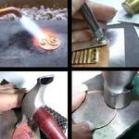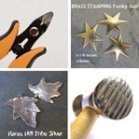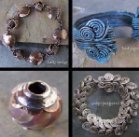Wire Coiling
by Michelle
(Boston, MA)
Hi Stacy,
How do you know how much wire to coil to make an inch of coil when doing bangle designs?
Michelle
Stacy's Answer:
You know, that's a very good question Michelle aaaaaaaaand...I don't know! I'm sure there's a math calculation for it so one doesn't have to guess or waste material. The inside diameter (larger ID = more wire used) and the thickness/gauge of the wire (the larger the gauge, the wider the wire = less coils needed per inch) x the length of said coil all figure into the equation. PLUS....one also has to consider that it's much easier to wrap a coil when you leave a tail of 2 inches or so to prevent the whole business from spinning. Of course the tail can be wrapped after the main body of the coil, becoming part of the equation...blah, blah, blah. whew! Too much measuring, too many varying factors, too much like work! All that can make your brain hurt! This kind of wire-work just doesn't require such exact precision. So..... I have a simpler way because I think jewelry-making should be fun - not to mention that all that figuring takes longer than just making the coil!
Instead of measuring each aspect of what it takes to create my coil, ( gauge, ID, length, the unknown factor for potential extra for additional wraps) I simply use a long piece of wire, make my coil and then cut only what I need from the longer length. But if you really want to know how much wire did you use? Here's a simple method.
When you are making the same size coil a lot, or anything for that matter, DO NOT undo the business and try to measure it. Do this.
1. Measure the start length of your wire.
2. Make your coil or component
3. Then measure the remaining length of wire.
4. Deduct the remaining length from the original length and TaDa! You have the exact amount of wire used in the component.
This formula works for all components and it's so EASY!!
Keep a design log and create components in copper or base metal. Glue or tape them to the paper and then write next to them the gauge and length of wire, mandrels, etc. used to create it. It's like having a little recipe for each item.
Comments for Wire Coiling
|
||
|
||
|
||
|
||
|
||
|
Click here to add your own comments Join in and write your own page! It's easy to do. How? Simply click here to return to Jewelry Q & A. |
















